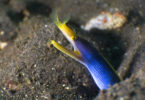Last Updated on November 19, 2022 by Matt
The Frogfish are a fascinating group of anglerfish which are small, stocky, and have modified pelvic and pectoral fins used for walking and holding themselves in place. They are benthic fish, not often swimming openly in the water column.
The most iconic feature of the frogfish is the lure that they use to attract prey. This lure is the front three spines of the dorsal fin, modified into a unique appendage called the illicium. At the end of the illicium is the lure, called the esca. The esca is different for each species, and is key in identifying species, as frogfish can look very similar!
While frogfish have captured the hearts and imagination of many, even becoming fairly popular in the aquarium trade, not much is known about frogfish reproduction. This is in part due to the fact that it is very hard to distinguish males and females, and also that they are difficult to keep fit and healthy in an aquarium setting.
In this quick information article we will discuss what is known about frogfish reproduction.
Frogfish Reproduction
Frogfish are solitary creatures, spending their time camouflaged among the coral and sponges of their reef habitat, patiently waiting for prey.
The only time they come together is for breeding, and in some species if the male stays too long after the fact the female will eat him!
Anywhere from a few days to several hours before being ready to mate the female will begin to produce eggs. Her stomach will swell notably as the eggs absorb water, and anywhere from 40,000 to 180,000 eggs can be produced by a single female.
About two days before spawning the male will begin to approach the female. It is unknown what stimulates the spawning; it could be phases of the moon, released hormones, or another external factor. When breeding pairs have been observed, the female has always been the larger of the pair, sometimes up to 10x larger.
The vast majority of frogfish species are free-spawning, with the females laying eggs at the surface of the water column. As is usual in the natural world, there are exceptions. Some species are substrate-spawning, attaching their eggs to the rocky substrate or even plants. While most substrate-spawning frogfish don’t guard their eggs, there are some that do. Guarding the eggs is a job that falls to the male. Other species instead practice brood carrying; frogfish of the genus Histiophryne carry the brood in the pectoral fins, while the three-spot frogfish, Lophiocharon trisignatus, attaches its eggs to the sides of the male.

Three-Spot Frogfish showing its eggs attached to the side of the male. Photo Credit: Mary Jane Adams and Irian Jaya
In the free-spawning frogfish, a courtship ritual is performed during which the male swims to the side and slightly behind the female, nudging her, but staying near her cloaca. The cloaca is the opening used for digestive, reproductive, and urinary tracts.
Immediately prior to spawning the female will swim up from the substrate to the surface. At the highest point of the swim the female will release her eggs, with the male sometimes aiding by helping remove the eggs with his mouth. The eggs are enclosed in a ribbon-like buoyant mass of mucus, which is referred to as an egg raft. After spawning the pair will separate; the female may eat the smaller male if he hangs around!
The eggs measure between 0.5-1 mm in diameter, and the egg raft can be very large. In sargassum frogfish the egg rafts can be up to a meter long and 7 inches wide.
After floating on the surface in the current for up to around 5 days the eggs will hatch. Fry will first survive on the yolk sac which is still attached. After this is used they will live planktonically until they have developed into the form of an adult frogfish at around an inch long. At this point they will swim to the seafloor and live benthically as a maturing frogfish. Frogfish have the ability to change coloration, and juvenile frogfish often mimic small poisonous and venomous flatworms.
Check out the video below of the striated frogfish releasing eggs!







